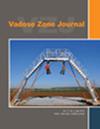通过水和硝酸盐的同位素追踪地下水层对肥料的冲刷情况
IF 2.8
3区 地球科学
Q3 ENVIRONMENTAL SCIENCES
引用次数: 0
摘要
农业系统中施用的氮(N)肥料有很大一部分没有被作物吸收,而是以硝酸盐(NO3-)的形式转移到根系以下。了解土壤氮在根区以下的滞留机制以及向地下水沥滤的机制,对于我们追踪所施氮肥的去向至关重要。我们使用硝酸盐(δ15N-NO3- 和 δ18O-NO3-)和水(δ18O-H2O 和 δ2H-H2O)的双稳定同位素来了解美国俄勒冈州威拉米特河谷南部灌溉玉米田三个深度(0.8 米、1.5 米和 3.0 米)的硝酸盐淋溶驱动机制。不同时期的硝酸盐浓度较高,而δ15N-NO3-值较低,这表明其中一部分硝酸盐来自最近施用的化肥。在这些 "化肥信号期",我们使用混合模型来量化与最近添加的化肥氮和较早的遗留土壤氮相关的硝酸盐通量。在这些时期,3.0 米以下浸出的硝酸盐在该深度浸出的总氮量中所占比例较大(52%),而在两个较浅的深度(13%-16%),这表明最近施用的化肥氮优先通过深层土壤进入地下水。秋冬季的大量降水可能会将残留的化肥氮推向深层,对地下水的潜在威胁大于遗留氮。本文章由计算机程序翻译,如有差异,请以英文原文为准。
Vadose zone flushing of fertilizer tracked by isotopes of water and nitrate
A substantial fraction of nitrogen (N) fertilizer applied in agricultural systems is not incorporated into crops and moves below the rooting zone as nitrate (NO3 − ). Understanding mechanisms for soil N retention below the rooting zone and leaching to groundwater is essential for our ability to track the fate of added N. We used dual stable isotopes of nitrate (δ15 N–NO3 − and δ18 O–NO3 − ) and water (δ18 O–H2 O and δ2 H–H2 O) to understand the mechanisms driving nitrate leaching at three depths (0.8, 1.5, and 3.0 m) of an irrigated corn field sampled every 2 weeks from 2016 to 2020 in the southern Willamette Valley, Oregon, USA. Distinct periods of high nitrate concentrations with lower δ15 N–NO3 − values indicated that a portion of that nitrate was from recent fertilizer applications. We used a mixing model to quantify nitrate fluxes associated with recently added fertilizer N versus older, legacy soil N during these “fertilizer signal periods.” Nitrate leached below 3.0 m in these periods made up a larger proportion of the total N leached at that depth (∼52%) versus the two shallower depths (∼13%–16%), indicating preferential movement of recently applied fertilizer N through the deep soil into groundwater. Further, N associated with recent fertilizer additions leached more easily when compared to remobilized legacy N. A high volume of fall and winter precipitation may push residual fertilizer N to depth, potentially posing a larger threat to groundwater than legacy N. Optimizing fertilizer N additions could minimize fertilizer losses and reduce nitrate leaching to groundwater.
求助全文
通过发布文献求助,成功后即可免费获取论文全文。
去求助
来源期刊

Vadose Zone Journal
环境科学-环境科学
CiteScore
5.60
自引率
7.10%
发文量
61
审稿时长
3.8 months
期刊介绍:
Vadose Zone Journal is a unique publication outlet for interdisciplinary research and assessment of the vadose zone, the portion of the Critical Zone that comprises the Earth’s critical living surface down to groundwater. It is a peer-reviewed, international journal publishing reviews, original research, and special sections across a wide range of disciplines. Vadose Zone Journal reports fundamental and applied research from disciplinary and multidisciplinary investigations, including assessment and policy analyses, of the mostly unsaturated zone between the soil surface and the groundwater table. The goal is to disseminate information to facilitate science-based decision-making and sustainable management of the vadose zone. Examples of topic areas suitable for VZJ are variably saturated fluid flow, heat and solute transport in granular and fractured media, flow processes in the capillary fringe at or near the water table, water table management, regional and global climate change impacts on the vadose zone, carbon sequestration, design and performance of waste disposal facilities, long-term stewardship of contaminated sites in the vadose zone, biogeochemical transformation processes, microbial processes in shallow and deep formations, bioremediation, and the fate and transport of radionuclides, inorganic and organic chemicals, colloids, viruses, and microorganisms. Articles in VZJ also address yet-to-be-resolved issues, such as how to quantify heterogeneity of subsurface processes and properties, and how to couple physical, chemical, and biological processes across a range of spatial scales from the molecular to the global.
 求助内容:
求助内容: 应助结果提醒方式:
应助结果提醒方式:


